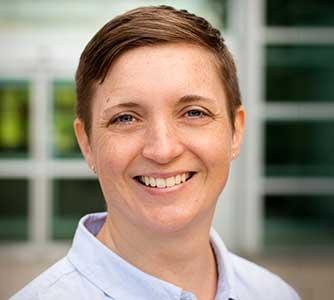Why is the Public Health Major so popular?
So many students are interested in health and want to make a difference. We’re giving them broader options to think about how they might be involved in the wellness of their families and their communities beyond traditional ideas of being a physician or clinician.
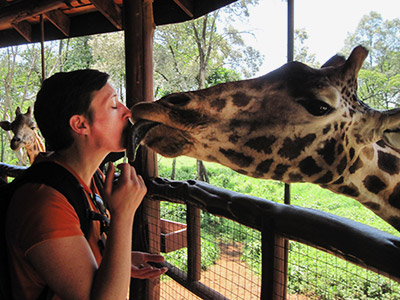
Susan makes a friend at a park in Nairobi
Will enrollment continue to rise? What’s next for the program?
It’s been grow, grow, grow. Now we’re at a place where we can stop and really think about how we’re doing things. We’ve got the students in the pipeline. We’ve got the core courses. Now, we need development beyond the core. Are we doing the best job that we can as instructors? Are we doing the best job we can as advisers?
What do we need to do in academic support to make sure they’re all going to be successful? Career development is another big area. Since we are a liberal arts degree, and not everyone will work in public health, where are they going?
What do you like most about your job?
Being able to operationalize the vision of the Dean (Howard Frumkin) and (Undergraduate Assistant Dean) Sara Mackenzie. I love that. Sara’s a big-picture person and I’m much more practical. I joined the Public Health Major because I believed in Sara’s passion of being able to "infect" undergraduates with enthusiasm for public health. Undergrads have a passion and idealism to change the world. They’re not jaded yet.
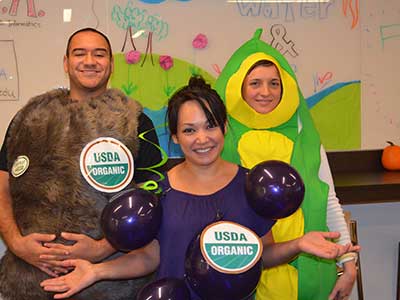
Disguised as pod of peas with colleagues Tory and Ardith
How diverse is our undergraduate student body?
We do a better job than most programs on campus. We spend a lot of time going through our admissions process and talking to prospective students. We could do admissions in minutes if we just looked at grades and test scores. But we’re making decisions based on someone’s potential to have impact on a community they’re part of, and we think that public health is all about that.
You’ve done a lot of fun things to promote our undergraduate programs. Why is that important?
We’re physically located on the south side of campus, where very few undergraduate programs are located. Coming into the Health Sciences Building is pretty intimidating. We want to meet students where they are. We also want the rest of the university to know there’s a School of Public Health and that we’re doing amazing things. By doing the petting zoo in The Quad during Dawg Days or the Field Day last year or the Decoration Challenge in our student lounge, we’re having fun but in a way that brings positive attention to our school and our program.
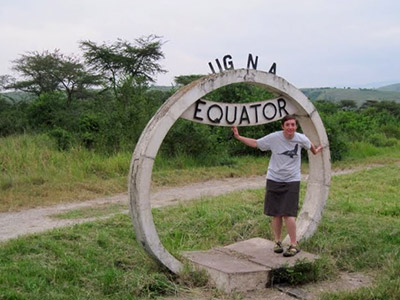
In Uganda in 2011
In advising, what are the most common issues for students?
We spend a lot time helping students navigate systems: The University, courses, major requirements, resources, and policies. We also help students unpack what a liberal arts education is, how they can leverage flexibility in our curriculum to engage in academic and extracurricular activities. We work closely with colleagues on campus to get students extra support for everything and anything that might be a barrier to their success. Sometimes we also need to give them a reality check. For prospective students, we help them conceptualize public health and its varied areas, how they see themselves fitting in, and what they imagine they might do following graduation.
What brought you to the UW?
I was working at the University of Texas-Austin as director of admissions for the School of Social Work, but I wanted to be closer to family. I followed my sister, who was doing a postdoc in neuroscience at the UW. Earlier, I had followed my sister to Charlottesville to work at the University of Virginia. We were the first ones in our family to go to college.
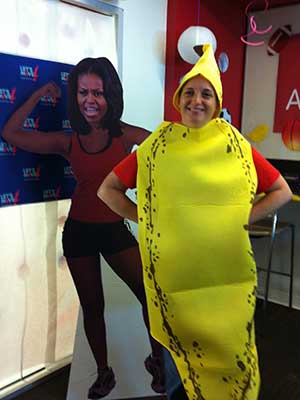
Going bananas during Dawg Daze
I was hired as a counselor with UW Admissions. My role was engaging with the community colleges about the new transfer holistic review process. After Initiative 200 in 1998, the university could no longer use race or affirmative action, so how do you get diversity? You get it through looking at other factors. I visited all of the community colleges in the state of Washington over five years.
What did you learn from that experience?
It was definitely rewarding work because it conceptualized how to help students get access to college. That goes back to my own experience as a first-generation student. Education creates the most level playing field for everyone, regardless of where they come from. How can I help people get to that playing field?
Later, I worked with the Environmental Health Major. You see students from the very beginning. You work with them. You see them graduate. And then you have a relationship with them as they’re an alum. That’s pretty powerful stuff. That longer-term connection is what drew me into student affairs, or student services, from admissions.
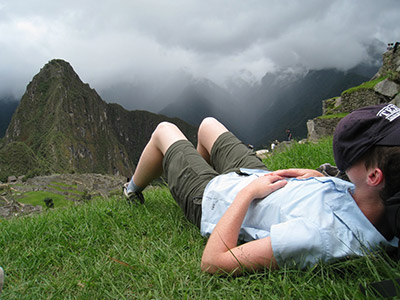
Relaxing in The Andes
What do you do for fun?
When I had a better work-life balance, I spent time outside and enjoyed running. Every other year or every third year, I try to make an international trip. I went to Southeast Asia last year, to East Africa (Kenya, Uganda and Rwanda) in 2011. In 2009, it was South America (Peru). In December, I’m going to the Galapagos Islands.
(By Jeff Hodson)
Originally published: December 2015
